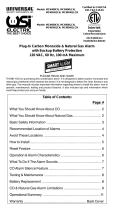
6
3. Other Alarm Visual and Audible Indicators
Operational Mode Visual Indications Audible Indications Action/Note:
Normal (standby)
AC power: Green LED on continuously
during light conditions, or blink every 60 sec
during dark conditions.
DC power: Green LED blink approx every 60 sec.
Test (button press when
no alarm condition is
present)
• 4 patterns of Red/Amber/Green.
• Test: Red LED blinks in time with
alarm pattern.
• Green LED fade on/o at test
complete
• Button press sound
• Voice: "Testing, this is very loud.
Press now to cancel test. 5, 4, 3, 2, 1."
• 3 long beeps, Voice "Fire!", 3 long
beeps, 4 quick beeps, Voice "Warning,
Carbon Monoxide," 4 quick beeps,
Voice "Test Complete," Power on/
reset sound.
• Voice "Test Canceled" if button
pushed before test sequence begins.
Perform Test/Hush button
press once a week to verify
proper alarm operation
* Push/release button before
the countdown ends to
cancel test.
Smoke or CO Alarm
Memory (unit has expe-
rienced a smoke or CO
alarm event within the
last hour)
Red and Amber LED alternate on 1
sec, every 10 sec.
After button push: "Smoke previously
detected" or "Carbon Monoxide
previously detected" only on the
initiating alarm unit.
Push test button to clear
Alarm Memory. NOTE: stan-
dard test sequence will follow.
(Push/release button again to
cancel test).
Smoke Alarm Hush
Mode, (SMART HUSH®
CONTROL)
Red LED blinks every 2 sec. After button push: "Hush Mode Acti-
vated." Smoke alarm pattern stops.
(If there is too much smoke to allow
Hush: Voice "Too Much Smoke, Alarm
cannot be Hushed" Smoke alarm
pattern continues.)
This feature is to be used
only when a known alarm
condition, such as smoke from
cooking, activates the alarm.
CO alarm reset None After button push: CO alarm pattern
stops.
Unit is conrming if CO is
present or if it experienced a
nuisance situation. Re-alarm
means danger. Move to fresh
air and call 911.
Locate None After button push on non-initiating
unit, only initiating unit continues
alarm pattern.
Use this to quickly locate the
alarm source and determine if
alarm is nuisance or real.
Smoke Alarm Hush
Mode Canceled
None Voice message "Hush Mode
Canceled."
When smoke levels drop
below the alarm threshold,
the voice message "Hush
Mode Canceled" will occur .
Initiating Alarm,
(Multiple alarms in an
interconnected system)
Green LED blinks once per sec indicating
that this is the unit initiating the alarm in an
interconnected, multiple alarm, system.
Unit in either Smoke or CO alarm
mode.
During alarm, the initiating
alarm red blink will be inter-
rupted by a green blink.























